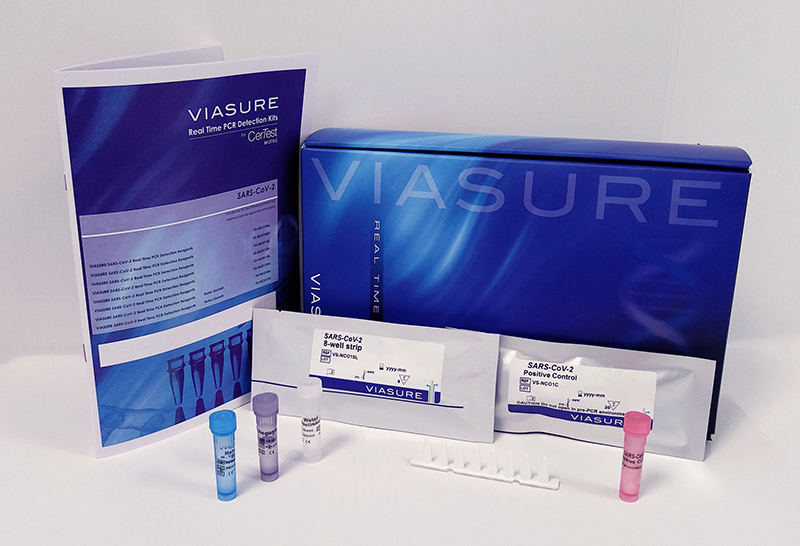
VIASURE Real Time PCR Detection Kits
SARS-CoV-2 Triplex (ORF1ab, E & N genes)

Description
VIASURE SARS-CoV-2 Triplex (ORF1ab, E & N genes) Real Time PCR Detection Kit is designed for the qualitative detection of RNA from SARS-CoV-2 in respiratory samples (nasopharyngeal swabs) from individuals suspected of respiratory infections by their healthcare professional (HCP).
This test is intended to be used as an aid in the diagnosis of SARS-CoV-2 infection in combination with clinical and epidemiological risk factors. RNA is extracted from clinical specimens. Complementary DNA (cDNA) is synthetised and amplified using real-time RT-PCR and detected using fluorescent reporter dye probes specific for SARS-CoV-2 (ORF1ab, E & N genes).
Specifications
Information
Coronavirus are enveloped non-segmented positive-sense RNA viruses and belong to Coronaviridae family. There are six coronavirus species known to cause human diseases. Four viruses (229E, OC43, NL63 and HKU1) cause common cold symptoms and the other two (severe acute respiratory syndrome coronavirus (SARS-CoV) and Middle East respiratory syndrome coronavirus (MERS-CoV)) are zoonotic and producing more severe complications. SARS-CoV and MERS-CoV have caused more than 10,000 cumulative cases in the past two decades, with mortality rates of 34% MERS-CoV and 10% SARS-CoV.
In December 2019, some people that worked at or lived around the Huanan seafood market in Wuhan, Hubei Province, China, have presented pneumonia of unknown cause. Deep sequencing analysis of the respiratory samples indicated a novel coronavirus, which was named firstly 2019 novel coronavirus (2019-nCoV) and lately SARS-CoV-2.
Human-to-human transmission of the SARS-CoV-2 has been confirmed, even in the incubation period without symptoms, and the virus causes severe respiratory illness like those SARS-CoV produced. Although the pneumonia is the principal illness associated, a few patients have developed severe pneumonia, pulmonary oedema, acute respiratory distress syndrome, or multiple organ failure and death. Centers of Disease Control and Prevention (CDC) believes that symptoms of SARS-CoV-2 may appear in as few as 2 days or as long as 14 days after exposure, being the most common fever, cough, myalgia and dyspnoea. Less common symptoms are sore throat, headache, diarrhoea and vomiting. It seems that people above 60 years old, males, and people with comorbidities most often have severe disease.
Diagnosis of SARS-CoV-2 infection disease (COVID-19) is performed detecting conventional causes of pneumonia early and detected by next-generation sequencing or real-time RT-PCR methods. Several assays that detect the SARS-CoV-2 are currently available, such as China CDC (gene targets, ORF1ab and N), Charité – Germany (gene targets, RdRP and E) or US CDC (two targets in N gene).
CDC recommends upper respiratory tract specimens (nasopharyngeal (NP) swab, oropharyngeal (OP) swabs, nasal mid-turbinate swab, nasal swab, nasopharyngeal wash/aspirate or nasal wash/aspirate (NW) and a saliva specimens collected mainly by a healthcare professional) and/or lower respiratory specimens (sputum, endotracheal aspirate, or bronchoalveolar lavage in patients with more severe respiratory disease) for the identification of SARS-CoV-2. In addition, other clinical specimens as blood, urine and stool may be collected to
monitor the presence of the virus.
